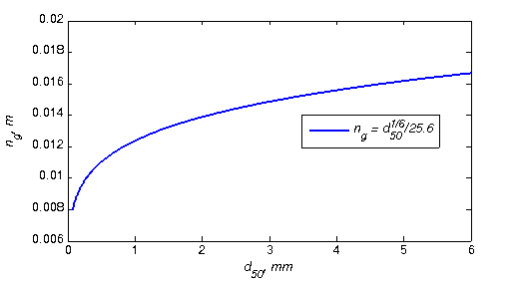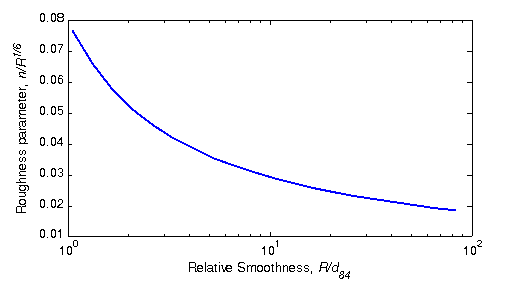Download PDF
Download page Bottom Roughness.
Bottom Roughness
The total roughness may be computed from the user-specified Manning's roughness coefficient or computed internally from the individual components. The total bottom roughness may be separated into roughness's due to (1) grains, (2) sediment transport, and (3) bedforms. The bedform roughness may be further divided into roughness's due to: (1) ripples, (2) mega-ripples, and (3) dunes. The grain-related roughness is the skin roughness caused by the sediment grains on the bed. It is necessary for many of the sediment transport formulas. The sediment transport roughness is a friction loss caused by the moving particles near the bed. The transport roughness is usually small compared to the other components. The bedform roughness is the form roughness and can have a large range of values. Bedforms geometry is very difficult to predict and therefore, the bedform roughness has a large uncertainty.
Roughness Specification and Conversion
The total bottom roughness is specified in HEC-RAS with the Manning’s roughness coefficient. It is important to note that the bed roughness is assumed constant in time and not changed according to bed composition and bedforms. This is a common engineering approach which can be justified by the lack of data to initialize the bed composition and the large error in estimating the bed composition evolution and bedforms. In addition, using a constant bottom roughness simplifies the model calibration. The bed roughness used for hydrodynamics may not be the same as that which is used for the sediment transport calculations. This is because each sediment transport formula was developed and calibrated using specific methods for estimating bed shear stresses or velocities, and these cannot be easily changed. The choice of what roughness parameter is specified and kept constant over an area has important consequences on the flow and its distribution with respect to the water depth (see figure below). The Nikuradse roughness height ks is related to the roughness length by (Christoffersen and Jonsson 1985)
| 1) | z_{0}=\frac{k_{s}}{30}\left[1-\exp \left(-\frac{u_{*}k_{s}}{27\nu }\right)\right]+\frac{\nu }{9u_{*}} |
where
u_{*} = bed shear velocity [L/T]
k_s = Nikuradse roughness [L]
ν = water kinematic viscosity [L2/T]
For flat beds consisting of fine sands or mud, the flow is hydraulically smooth or transitional while beds with coarse sands, gravel, or bedforms are hydraulically rough (Soulsby 1997). Most natural river and coastal flows are hydraulically rough for which case the above equation simplifies to
| 2) | z_{0}=\frac{k_{s}}{30} |
The equation is based on a logarithmic velocity profile and covers smooth, transitional, and rough turbulent flows.
Assuming rough turbulent flow, the second part of the equation may be ignored, in which case the Colebrook-White equation may be used to convert the roughness height to a Manning’s coefficient as
| 3) | n=\frac{AR^{1/6}}{18\log _{10}\left(\frac{12R}{k_{s}}\right)} |
where
A=\left\{\begin{array} 1\,\,\,\,\,\,\mathrm{for}\,\mathrm{SI}\,\text{units}\\ 1.486\,\,\mathrm{for}\,\text{English}\,\text{units} \end{array}\right.
R = hydraulic radius or water depth [L]
k_s = roughness height [L].
Grain-related Roughness
The grain-related roughness may be estimated as (e.g. Meyer-Peter and Muller 1958)
| 4) | k_{s, g} = α_g, _Xd_X |
where
α_{g,X} = Grain-related roughness height coefficient
d_{X} = Diameter corresponding to the X percentile
Examples values of αg, X from literature are shown in the table below.
Table 25. Grain-related roughness height coefficient.
| Reference | dX | αg, X |
|---|---|---|
| Ackers and White (1973) | 1.23 | |
| Meyer-Peter and Muller (1948) | 1.0 | |
| Engelund and Hansen (1972) Nielsen (1992) | 2.50 | |
| Strickler (1970) | 3.3 | |
| Engelund and Hansen (1967), Wilcock (2001) and Wilcock and Crowe (2003) | 2.0 | |
| Limerinos (1970) | 2.8 | |
| Kamphius (1974) | 2.0 | |
| van Rijn (1984c) | 3.0 |
In HEC-RAS, the grain roughness height formulations utilized from the above table are van Rijn (1984c)
The grain-related Manning’s roughness coefficient may be estimated as
| 5) | n_{g}=\frac{d_{X}^{1/6}}{A_{n,X}} |
where
d_X = Xth percentile diameter [m]
A_{n,X} = Grain-related Mannings n corresponding to dX [1/(s m1/6)]
The table below shows some examples of An from literature.
Table 26. Grain-related Manning’s coefficient.
| Reference | ||
|---|---|---|
| Strickler (1923) | 25.6 | |
| Li and Liu (1963) | 20 | |
| Patel and Ranga Raju (1996) | 24 | |
| Meyer-Peter and Muller (1948) | 26 |

Figure 2 3. Example grain Manning's roughness coefficient following Strickler (1923).
Limerinos
Limerinos (1956) developed a bed roughness predictor based on data from 11 gravel-bed streams in California as (see Figure below)
| 6) | n_{g}=\frac{0.0926AR^{1/6}}{1.16+2\log _{10}\left(R/d_{84}\right)} |
where
A=\left\{\begin{array} 1.219\,\,\,\,\mathrm{for}\,\mathrm{SI}\,\text{units}\\ 1\,\,\,\,\,\,\,\,\,\,\,\,\,\,\mathrm{for}\,\text{English}\,\text{units} \end{array}\right.
n_g = grain-related Manning’s roughness coefficient [s/m1/3]
R = hydraulic radius [L]
d_{84} = 84th percentile diameter [L]
The equation is applicable to high in-bank flows in straight, gravel-bed channels. All the data used corresponded to Froude numbers less than 1. The Limerinos equation only accounts for the grain roughness in gravel-bed streams and does not include other contributions. Therefore, it may be used as the base value in the Cowan (1956) method.

Figure 2 4. Grain roughness using the Limerinos (1956) equation.
It is noted that none of the expression above account for the full distribution of sediments and only consider a representative diameter. This is a limitation of the expressions when being applied to poorly sorted bed material.
Sediment Transport Roughness
Moving sediment produces a roughness due to the energy losses in transporting the sediment. This process is poorly understood and relatively few expressions are available in literature to account for this process. Here two simple formulas are available which account for the added roughness of bed-load transport. The formulas included here for sediment transport roughness are:
- Wilson (1966)
- Wiberg and Rubin (1989)
Wilson (1966)
A commonly used formula for the sediment transport related roughness is the Wilson formula (Wilson 1966, 1989ab)
| 7) | k_{s, s}= 5θ′d |
where
\theta ' = \frac{\tau '_{b}}{g(\rho _{s}-\rho )d} = grain-related Shields number [-]
d = grain size diameter [L]
The above formula has been used by Camenen and Larson (2007) and others. The above equation must therefore be solved simultaneously with the expressions for the bottom shear stress because the roughness depends on the stress. The exact solution is approximated here using explicit polynomial fits in order to avoid time-consuming iterations in calculating the bed shear stress.
Wiberg and Rubin (1989)
Wiberg and Rubin (1989) proposed the following formula for the sediment transport related roughness
| 8) | k_{s,s} = 30\alpha _{WS}d_{50}\frac{a_{1}\tau '_{b}/\tau _{cr}}{1+a_{2}\tau '_{b}/\tau _{cr}} |
where
k_{s, s} = sediment transport related roughness height [cm]
d_{50} = median grain size [cm]
τ'_b = grain shear stress [M/L/T2]
τ_{cr} = critical shear stress [M/L/T2]
α_{WS} = 0.056 [ - ]
a_1 = 0.68 [ - ]
a_2 = 0.0204\ln(100d_{50})^2 + 0.022\ln(100d_{50}) + 0.0709 (~0.27) [ - ]
The formula is based on the hypothesis that the transport roughness is directly proportional to the thickness of the bed-load layer proposed by Owen (1964). The formula is basically that of Dietrich (1982) with recalibrated coefficients.
Bedform Roughness
Ripple Roughness
The ripple roughness may be estimated as (see Grant and Madsen 1982; Nielson 1992; and Soulsby 1997)
| 9) | k_{s,r}=\alpha _{r}\frac{\Delta _{r}^{2}}{\lambda _{r}} |
where
k_{s,r} = ripple roughness height [L]
α_r = \text{ripple roughness coefficient on the order of 10 [ - ]}
\Delta _{r} = \text{ripple height }[L]
λ_r = \text{ripple length }[L]
Examples values of αr from literature presented in the table below.
Table 27. Ripple Roughness Height Coefficient.
| Reference | |
|---|---|
| Grant and Madsen (1982) | 27.7 |
| Nielsen (1992) | 8 |
| Raudkivi (1997) | 21.7 |
| Soulsby (1997) | 7.5 |
| van Rijn (1993) | 10 |
Dune Roughness
For dunes van Rijn (1984c) method is given by
| 10) | k_{s,d}=1.1\gamma _{d}\Delta _{d}\left[1-\exp \left(-25\frac{\Delta _{d}}{\lambda _{d}}\right)\right] |
where
γ_d = dune shape coefficient (~1.0) [ - ]
\Delta _{d} = dune height [L]
λ_d = \text{dune length }[L]
The dune shape coefficient, γd, is approximately 1.0 for dunes with angle-of-repose faces as considered in van Rijn (1984c). Dunes with more gently sloping faces have smaller shape coefficients as is common in the field. Van Rijn (1993) proposed setting γd = 0.7 based on various field measurements of river systems. van Rijn (1984c) provided expressions for calculating the dune height and length and are shown in Equations (2-94) and (2-95). The figure below shows the dune roughness based on van Rijn (1984c) as a function of the sediment transport stage.

Figure 2 5. Dune roughness height based on van Rijn (1984a).